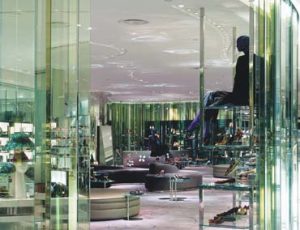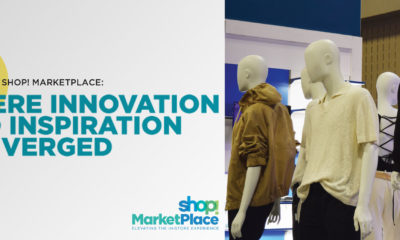If stores are like children, each with its own distinct personality, then Lane Crawford's Hong Kong flagship is the mature, more-tailored older sibling. And its latest store prodigy at Pacific Place is the younger wild child, breaking formality and convention to make its mark in the retail world.
Renowned design firm Yabu Pushelberg (Toronto) worked with Lane Crawford, the super-centenarian luxury department store chain, to develop and nurture both stores' personalities. “They want each of their stores to have a slightly different attitude,” says managing partner Glenn Pushelberg. “So there's an overriding sense of style and quality of design and detail. But they take on different characteristics that give each store an element of surprise and sense of wonderment.”
For the renovated Pacific Place location, Yabu Pushelberg wanted a kinetic environment that would appeal to the young trend-followers who flock there. Part of that energy was interactive technology, in obvious and subtle ways.
Starting at the cashwrap, designers created a long sculptured i-Bar where customers can check e-mail from several laptops while closing out their purchases. The CD-Bar features iPod sound stations and a Bose sound system with 12 separate music zones that host live deejay sessions on the weekends.
Some of the technology is just for fun. Heat-sensitive paint on the counters reacts to the slightest touch of a hand, leaving a momentary impression. Or, when no one is near, hidden heating coils on a timer warm the paint from underneath to reveal patterns of florals and stripes.
“The customer is always being engaged by someone or something,” says creative director George Yabu.
Shoppers are similarly engaged throughout the store. Near the women's sportswear department, translucent glass screens come to life when shoppers pass by, revealing video art created by local art students. “The images react to the movement of passing human bodies,” says Yabu. “It's far more engaging than watching a fashion video.”
Shunning conventionality, the retailer replaced traditional store windows with video and 3-D art installations. “The store is located in a highly competitive market,” says Yabu, “so we didn't think we needed one more static window display.”
Back inside the store, designers installed a working dry cleaning conveyor belt in the men's athletic footwear department, creating a moving display of shoes and the latest Japanese toys. “It blurs that line between art and commerce,” says Yabu. “So it's not always sell, sell, sell. It makes you have a less cynical perspective of retail.”
Pushelberg says this technology-as-art approach is less calculating and more ethereal – something that he attributes to Asian culture. “In America, we tend to be more market-driven and premeditated in how stores are planned and merchandised,” he says. “Here, we tried to be more artistic and romantic. In our mind, that makes the store more engaging to the shopper, differentiates it from the other stores out there.”
While technology makes the statement, materials and color are the finishing touches in this dynamic experience.
Designers laid out the store as a series of artistic rooms, each with its own character. So the jewelry department features a dichotomy of back-lit yellow walls and organic black charcoal wood with chrome fixtures. The men's shoe department houses yellow shoe display bases and gold leather sofas, while the women's shoe area has mauve-colored carpet and laminated green glass screens in a barcode pattern. Nearby, handbags are displayed on copper fixtures. Still in the works is a floating glass staircase.
“We were looking for something more spirited, colorful and playful,” says Pushelberg.
Since the store is small in department store terms – measuring only 50,000 square feet -Yabu Pushelberg eschewed the stockroom, bringing back-stock to life on the sales floor behind transparent sliding wall panels which can be moved by customers or sales associates alike. In the shoe department, where 30 percent of the space is typically devoted to stockroom space, the display resembles a library wall. “So even though the transparent doors are closed, the customer is conscious that the shoes are close at hand,” says Yabu. “And now the customer isn't left alone while the sales associate goes to fetch a pair.”
While both design partners recognize that Lane Crawford's Pacific Place customer is the type to “give us more leeway on how to sell a product,” they feel that such convention-breaking measures have a place in the future of all high-end retail. “One has to question how far the individual brand store can go before it's run its course,” says Pushelberg. “I think if you create an environment that is more dynamic and less premeditated in its marketing approach, it engages the customer longer and has a greater appeal to them.”
Client: Lane Crawford, Hong Kong
Design: Yabu Pushelberg, Toronto
George Yabu, partner
Glenn Pushelberg, partner
Photography: Nacása & Partners Inc., Tokyo

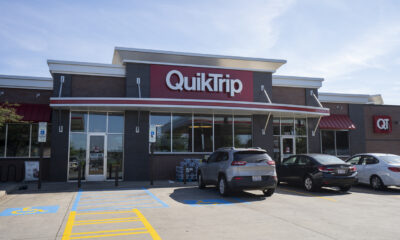
 Headlines2 weeks ago
Headlines2 weeks ago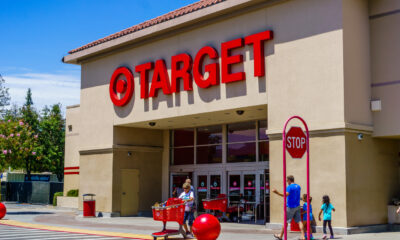
 Headlines2 weeks ago
Headlines2 weeks ago
 Headlines3 days ago
Headlines3 days ago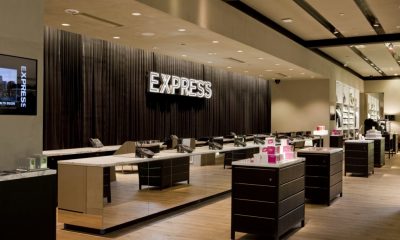
 Headlines5 days ago
Headlines5 days ago
 Headlines4 days ago
Headlines4 days ago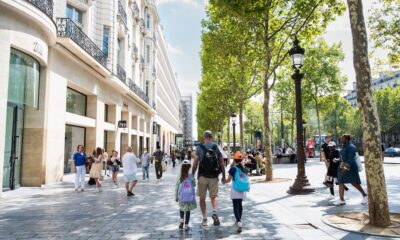
 Headlines1 week ago
Headlines1 week ago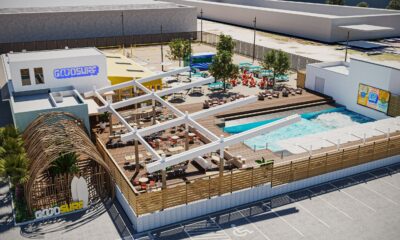
 Headlines1 week ago
Headlines1 week ago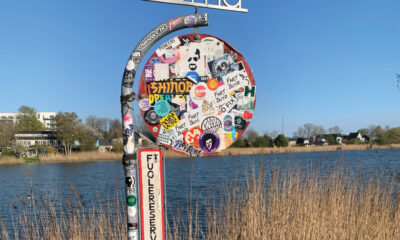
 NEXT UX2 weeks ago
NEXT UX2 weeks ago



